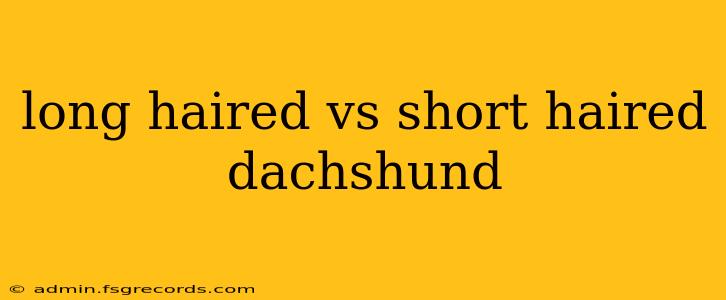The dachshund, with its charming long body and short legs, is a beloved breed worldwide. But did you know there are actually three coat variations: smooth, long-haired, and wirehaired? This article delves into the key differences between long-haired and short-haired (smooth-haired) dachshunds, helping you decide which furry friend best suits your lifestyle.
Coat and Grooming Needs: A Significant Difference
The most obvious distinction lies in their coats. As the names suggest, short-haired dachshunds boast a sleek, smooth coat that requires minimal grooming. A weekly brush is usually sufficient to remove loose hair and keep their coat healthy.
Long-haired dachshunds, on the other hand, have a longer, softer coat that requires significantly more attention. Daily brushing is recommended to prevent mats and tangles, especially around their ears and legs. Regular baths may also be necessary, depending on their activity level and the environment. This breed is also more prone to shedding, especially during seasonal changes.
Grooming Summary Table:
| Feature | Short-Haired Dachshund | Long-Haired Dachshund |
|---|---|---|
| Coat Length | Short, smooth | Long, soft |
| Brushing Frequency | Weekly | Daily |
| Shedding | Minimal | Moderate to High |
| Bathing | Infrequent | More frequent |
Temperament and Personality: Subtle Variations
While both long-haired and short-haired dachshunds share the breed's characteristic traits – courage, stubbornness, and playfulness – some subtle differences in temperament have been observed. Anecdotally, some owners report that long-haired dachshunds might be slightly more sensitive and affectionate than their short-haired counterparts. However, it's crucial to remember that individual personalities vary greatly within each coat type, influenced by factors such as genetics, socialization, and upbringing.
Health Considerations: Similar Vulnerabilities
Both long-haired and short-haired dachshunds are prone to similar health issues, primarily due to their elongated body structure. These include:
- Intervertebral Disc Disease (IVDD): This is a common problem in dachshunds, leading to back pain and potential paralysis.
- Obesity: Dachshunds can easily become overweight, exacerbating IVDD and other health problems.
- Eye problems: Certain eye conditions, like progressive retinal atrophy, can affect both coat types.
Regular veterinary checkups, a healthy diet, and appropriate exercise are essential for maintaining the health of both long-haired and short-haired dachshunds.
Choosing the Right Dachshund for You
Ultimately, the best dachshund for you depends on your lifestyle and preferences. If you're looking for a low-maintenance dog that requires minimal grooming, a short-haired dachshund might be the ideal choice. However, if you enjoy grooming and are prepared to dedicate more time to daily brushing, a long-haired dachshund could be a perfect match for your affection and patience. Remember to consider your activity level and living space when making your decision.
Conclusion: More Than Just a Coat
The differences between long-haired and short-haired dachshunds extend beyond their coats. While their temperaments are largely similar, their grooming needs differ significantly. Careful consideration of these factors will help you choose the right dachshund companion to share your life with. Regardless of coat length, a well-cared-for dachshund will bring boundless joy and unwavering loyalty to its human family.

